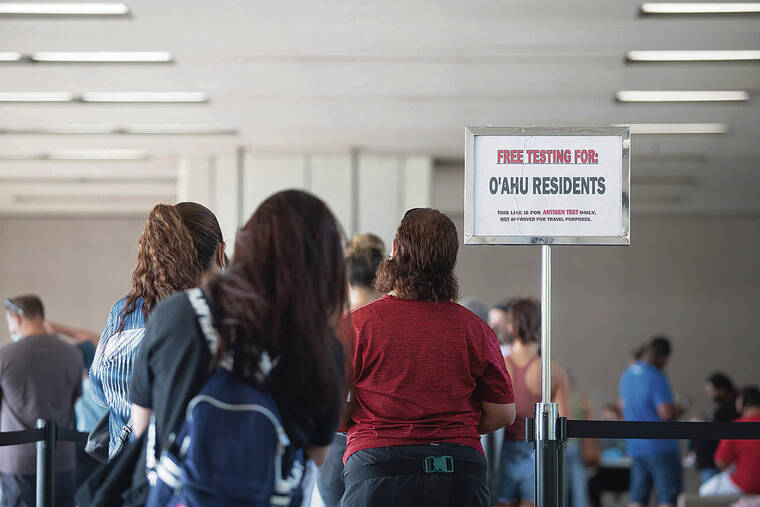Mu variant detected in Hawaii, but threat is low now


CINDY ELLEN RUSSELL / CRUSSELL@STARADVERTISER.COM
Keoni Paul swabbed his nose during a COVID-19 test outside of Terminal 2 at Daniel K. Inouye International Airport on Tuesday.

COURTESY PHOTO
Sarah Kemble:
The state epidemiologist says that despite a dip in cases “we are not out of the woods yet”

CINDY ELLEN RUSSELL / CRUSSELL@STARADVERTISER.COM
People waited in line for free testing.




The mu variant of the coronavirus Opens in a new tab, which may be better at evading protections offered by the available vaccines, has been found in nearly every state, including Hawaii, where its prevalence is second only to Alaska, according to data from Scripps Research.
The variant has been flagged by the World Health Organization as a “variant of interest,” and Dr. Anthony Fauci, director of the National Institute of Allergy and Infectious Diseases, said recently that it’s something officials are “keeping a close eye on.”
But local health experts say they don’t consider the variant to be a particular threat right now.
There have been 39 cases of the variant detected in Hawaii, representing about 1% of samples, according to data published on the outbreak. However, there is no indication that the variant is taking hold in the islands amid the dominance of the delta variant, which now makes up almost all cases in Hawaii.
State epidemiologist Sarah Kemble said most cases involving the mu variant in Hawaii were detected back in June and the variant seems to have since subsided. The strain has so far not been flagged by the Centers for Disease Control and Prevention as a “variant of concern” and is not being reported by the state in its biweekly variant reports, which highlight prevalent strains in the state based on genome sequencing of a fraction of positive specimens.
“Part of what makes a variant a ‘variant of concern’ is not just the characteristics about that particular strain, but also, what’s the propensity of that strain to take over and become the dominant strain,” Kemble told reporters during a press call on Tuesday. “We’re not seeing that. We’re really seeing that delta seems to have found its niche here and that’s still well over 95% of the cases we’re seeing in the state.
Don't miss out on what's happening!
Stay in touch with breaking news, as it happens, conveniently in your email inbox. It's FREE!
“So our current problems are really driven by delta, not mu.”
Infectious disease expert Tim Brown also said that the mu variant wasn’t one he was particularly worried about, noting that cases of the mu variant also have been dropping globally.
While some scientists hope that the delta variant will prove the apex of the pandemic, before severe illness and deaths drop significantly amid a population increasingly protected by vaccinations and natural immunity from being infected, Brown said new variants still could cause problems, even if it’s not mu.
“So far delta definitely is the worst we’ve seen,” he said. “Now could something more come along? It’s possible, we just don’t know at this point.”
Eventually, epidemiologists expect the virus to become like others that we live with on a daily basis.
“In general, once people have built up some resistance to it, that’s what is happening is the population is building resistance to it, then at that point it becomes like a common cold,” said Brown, who is a senior fellow at the East-West Center. “But the problem we have right now is we don’t know how long it is going to take to get there.
“It’s conceivable, we could get there after delta, but it’s also conceivable that we may have to go through three or four more evolution cycles of the virus before it finally settles into something that basically is not going to mutate because it’s reached peak fitness.”
The highly-transmissible delta variant has caused COVID-19 cases to soar in Hawaii since early July, sending hospitals into crisis mode as they struggle to deal with the influx of patients amid staffing and oxygen shortages. On Tuesday, the Department of Health reported 499 new coronavirus cases, including 364 new cases on Oahu, 38 on Maui, 50 on Hawaii island, 45 on Kauai and two Hawaii residents diagnosed outside the state.
Over the past week, the state has averaged 706 new cases a day, compared to last week’s average of 891 new cases a day. While the current average is still remarkably high for Hawaii, Kemble said it could indicate a “slight reprieve.”
“But we are not out of the woods yet,” she cautioned, noting that a month ago, 700 cases would be considered an “incredibly high case count.”
The number of patients in Hawaii’s hospitals with COVID-19 also remains precariously high, jumping from 436 on Friday to 473 on Tuesday, according to state data Opens in a new tab. Hospitals have already been rationing care by delaying surgeries and procedures that are elective or can be postponed without causing significant harm.
Hospital officials have warned that they may have to implement “crisis standards of care,” including making decisions about who to save, if things continue to get worse.





